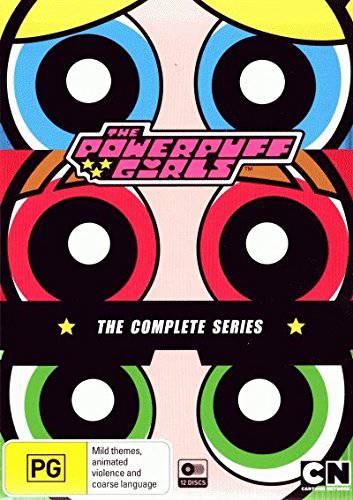Retro Ranting – The Powerpuff Girls
I want to invite all you sexy, intelligent and cultured Skwigly readers to put yourselves in my shoes. Seriously, go ahead. Slither right in.
There ya go.
You’re now a stocky man in his late-twenties, eminently strokable in the beardy regions, able to subsist on a diet of powdered soup, chicken skin and Aberlour for days on end.
Decadent, ain’t it?

Now, turn the clock back a decade or so. You’re reaching the end of your teens and vaguely resemble a giant potato with stubble. You’re trying to explain to your peers the appeal of a certain Cartoon Network show:
“It’s like…well, it’s for kids, but it’s not.”
“Like The Simpsons?”
“Well, no. It’s more like…an actual kids’ show…”
“But with grownup jokes?”
“Eh…not really, but…”
“What’s it about?”
“See, it’s three girls. And they fight monsters with their superpowers. They’re sisters.”
“Oh.”
“Yeah.”
“That doesn’t sound all that -”
“No no no, it’s really, really good. There’s, like, the sensible redhead one and the sort of feisty tomboy one and the ditzy blonde one…”
“Oh, I get it. So they’re hot.”
“Uh…not really. They all kinda look like Frank Sidebottom. And I think they’re meant to be about five years old.”
“I see.”
“Yep.”
“I’m finding this conversation very unsettling.”
“As well you should.”
“Please refrain from speaking to me in future.”
“I understand completely.”
Exit. Pursued by a bear.
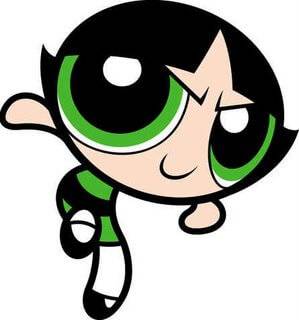
Buttercup. The post-feminist Powerpuff. Possibly.
Such was the lament of all Powerpuff Girls fans who didn’t happen to be preadolescent and female. The world just didn’t understand, nor could they without giving it the hours of semi-drunken attention I’d had by that point.
See, when all my friends in secondary school were studying to become future world leaders, I was carving out more of a Worthless Piece of Human Garbage niche for myself by going out most nights to cackhandedly hit on townies, get hammered and come home to late-night animation (when they’d be repeated with that woman doing sign language in the corner of the screen – it always struck me as insult to injury that the poor deaf kids had to stay up til 2am just to watch cartoons) until I passed out. One show, the brainchild of CalArts graduate Craig McCracken, both freaked me out and grabbed my attention with its abrasive cuteness, something of an odd combination at the time. Nothing about Powerpuff Girls was, at first glance, something I should’ve been a fan of. The type of TV my brain was tuned into back then mainly centered around Martin Sheen’s idyllic presidential rule of The West Wing and James Gandolfini delivering hard-hitting sociopolitical statements via his fists in The Sopranos. Even the cartoons I’d moved onto were unambiguous in their intended adult audience; A promising new talent named Seth MacFarlane was charming the land with his fresh brand of edgy comedy that would doubtless prove inimitable and timeless (sorry, cheap shot). Against this backdrop, what possible appeal would a seemingly kitsch, Anime-informed show for – and about – infants have for such a classy – nay, damned classy – fellow as I?
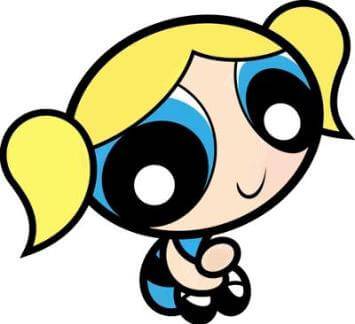
I really feel I should settle down with a nice girl like Bubbles, but I always wind up with the Buttercups. And yes, I’m well aware of how creepy that looks written down.
I suppose we were the Bronies of our generation. After a few minutes you either got it or you didn’t – that alternately beneath or above the surface of innocuous kids’ fare there was something a lot more clever, sharp and self-aware going on. Little tells such as the passive-aggressive asides the show’s narrator (Tom Kenny) would make, or the blink-and-miss-them double entendres and obscene sleight-of-hand sight gags all cultivated a general sense that the folks behind what you were watching were up to something not nearly as innocent as the squeaky voices and bright colours would have you initially believe.
The show is essentially a retooled television offshoot of McCracken’s student short A Sticky Situation, which in itself goes some way to explaining the equivocal vibe of the show it’d eventually become. The story is of a lone professor who, for reasons that aren’t addressed but one assumes are innocent enough, attempts to create the perfect girls in his laboratory, absent-mindedly chucking in a ‘can of Whoopass’ (later changed to the more generic ‘Chemical X’) for good measure. The results are Blossom, Bubbles and Buttercup, three adorable freaks of nature with giant exophthalmia eyes and fingerless stumps for arms who go by the collective term ‘The Whoopass Girls’ and do battle with appropriately ludicrous villains ‘The Amoeba Boys’. Unfinished (and rather threadbare) Whoopass Stew story outlines intended to accompany A Sticky Situation exist in animatic form, though it wasn’t until McCracken’s involvement with the sometimes-inspired Cartoon Network What A Cartoon! showcase that the trio made it onto television, rechristened The Powerpuff Girls. Though the oft-confusing (over fifteen years later and people are still saying ‘powderpuff’) title change suggests a watering-down, the ass-whoopin’ component remains the main driving force of these shorts, as well as the series proper which mainly ran from 1998-2004.
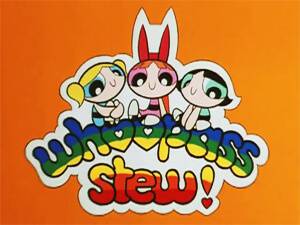
Title card for ‘Whoopass Stew!’, the precursor to PPG.
The hyper-cutesiness serves as both a comically effective juxtaposition against said (at times, rather extreme) violence and as a network-placating façade to disguise the odd risqué aside that are too on-the-nose to be accidental. A lot of its charm and, possibly, success is down to the involvement of Dexter’s Lab creator Genndy Tartakovsky in various capacities – indeed, the show itself is something of a spiritual sibling to Dexter itself, both shows involving much of the same crew and a not-entirely-dissimilar aesthetic. The stripped down visuals combined with effective use of limited animation gave both endeavours a charming, budget-conscious retro vibe, something that prior shows such as Ren & Stimpy had paved the way for but not fully indulged themselves.
What kept me a fan beyond the initial curiosity was that, for any cynicism and dodgy moments, at its core was genuine joyfulness and thoughtful character work. The three heroines are as fallible as they are endearing, often misguided and self-involved in a way that stays true to them being little girls before superheroes. Probably the most laudable performance is Bubbles (Tara Strong), whose sweetness and light gives way wonderfully to moments of extreme brattiness and rage; it’s a sort of adorable schizophrenia anyone with kids would doubtless relate to. Buttercup (Elizabeth Daily, whose voice characterisation isn’t a million miles away from her prior role as Tommy in Rugrats) is the most relatable, especially as I grow older and the world incrementally grinds my soul to dust – as the obligatory tomboy she’s embittered, violent, pissy and, as such, incredibly likeable. The self-proclaimed leader is Blossom (Cathy Cavadini) whose main leadership trait is being grounded and, comparatively speaking, sort of forgettable. The accompanying populace are standard cartooney fare, the Mayor (Tom Kenny again) a suitably incompetent manchild, his assistant an empowered career woman with the standard-issue assets – we never see anything higher than her chest – and Professor Utonium (Tom Kane), the girls’ creator/father figure whose function is mainly to prod expository scenes along.
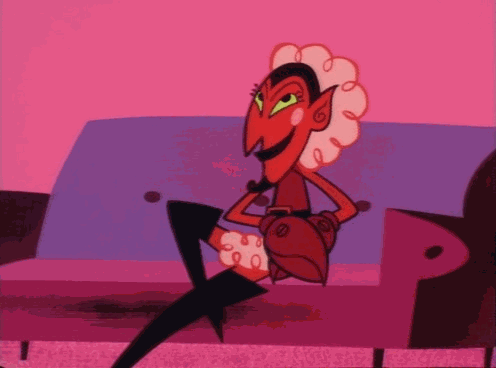
‘Him’. A cartoon villain Hall-of-Fame-er
Obviously it’s the villains of the show that steal it, and while it would be a piece in and of itself to list the virtues of all of them, a special nod should go to Him (Kane also), possibly one of the least explicable villains in cartoon history: A sort of Jim Flora-esque transgender lobster/devil figure with a penchant for cross-dressing, falsetto taunting and perversely licking his victims’ faces. McCracken has cited the Blue Meanies of Yellow Submarine as the main influence for the character, though frankly that still leaves a lot of questions unanswered.
All these elements mixed together with a long stretch of consistently bizarre and creative story ideas make the show sincerely compelling for several seasons, and even in the first handful of episodes where the show is finding its footing there’s a contemporary energy to it that holds up today, one that may have even been a bit before its time back when they originally aired.
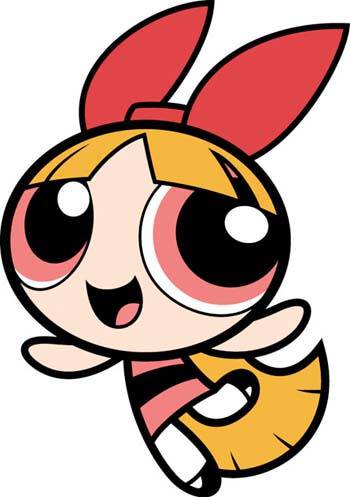
Blossom. The sensible one. Yawn.
Inevitably there comes a point where the valleys become more evident than the peaks, hot on the heels of a particularly strong batch around the season 3 mark. The fourth season indulges a sudden tendency toward double-length episodes, which is a little jarring in its immediate shift of pacing; The frenetic energy of the show is replaced by protracted stories that come off as heavily padded. Used sparingly in its heyday, these moments are fair enough and sometimes a welcome relief from the relentlessness of the action, but when you reach the point where Bubbles is making cat noises for a solid minute it gets mildly insufferable.
Perhaps this was felt within the production itself, as they largely revert back to the eleven-minute episode standard as the season progresses. Noticeable at this stage is a not-entirely-seamless mid-season switch to digital production, which one wouldn’t think would affect the overall tone much. Yet the sudden crispness of the line work and colours, married with the increasingly angular design style start to give it a vaguely cold feel. There are still strong gags littered about the place, but the sly, self-aware undercurrent that roped its older audience in doesn’t seem to be as much of a presence. It becomes, at the end of the day, a show for kids – albeit a strong one – without that second layer of nudge-winkery. As such there isn’t much of a sense that the show has outstayed it welcome when it finishes, nor is there any particular feeling of being left wanting more. It runs its course and taps out at pretty much the right time, which is a rarity in the world of merchandisable TV animation.
Accompanying the main series are a handful of one-off adventures. See Me, Feel Me, Gnomey is a banned-in-the-US (for utterly inconsequential reasons) rock opera pastiche that doesn’t quite gel; It’s fun musically but the banality of the lyrics and the story coupled with the absence of any real humour gives it a sort of missed-opportunity feel.
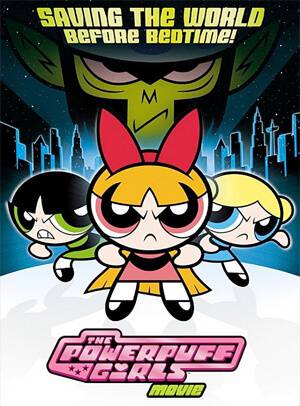
Yeah, there’s no need for that…
Though technically separate from the series itself, the 2002 Powerpuff Girls Movie is another strange aberration, a theatrically-released prequel story produced around the halfway mark of the show’s run. One assumes that its revamping of the overall design style is what led to the aforementioned shift in look of subsequent seasons, and it similarly detracts from the warmth of the characters and premise. Mainly it’s the writing that lets it down – the frightfully tepid jokes seem aimed toward a much younger audience, as does the sense that it’s actually taking itself seriously, which sort of undermines what made the show so endearing in the first place. It wins back points for its abundance of animated mutant monkeys, however.
On a more positive note, the 40 minute, McCracken-directed holiday special ‘Twas The Fight Before Christmas is a brilliantly written and executed celebration of what made the show strongest at its peak – densely packed with jokes and action alike. Some years later, in celebration of the show’s ten-year anniversary, McCracken also directed a celebratory ‘final’ episode, The Powerpuff Girls Rule! If the slower pacing of the latter seasons induced mild fatigue in the viewer, this special wakes you up with the impact of a violently administered hot coffee enema. Or ice-coffee enema – either way, you’re up and there’s no snooze button in sight.
At first glance it’s a step backwards animation-wise, having the overall look of a webtoon, though it quickly becomes apparent that it’s a purposeful return to the hyper-intense, freeform mania of the earliest episodes and McCracken’s original Whoopass Stew shorts (the storyline involving a ‘key to the world’ is a nod to one of the unproduced ‘Stew stories), then sped-up, amplified and repeatedly smashed into your face. Though in some respects the cartoon equivalent of waterboarding, it is perhaps the most gloriously undiluted version of the show. We’re barraged with a parade of what would be familiar characters, except they all seem to have been slipped PCP. While the batshit craziness of it all is, to me, rather delightful (the payoff gag when series villain Mojo Jojo finally attains world domination is so fantastically stupid I find myself giggling like the emotionally-stunted tool I am for three straight minutes) I can’t help but wonder if it proved overwhelming to fans of the mellower version of what the show had grown into.
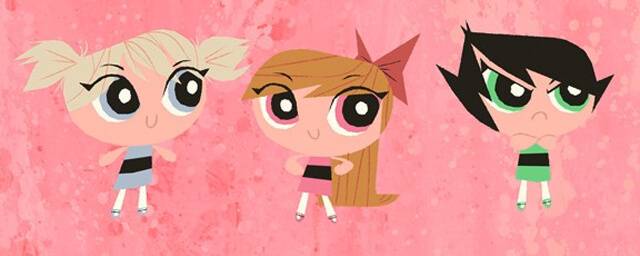
I’m kinda hoping this isn’t actual concept art.
It’s understood that there’ll be another special aired later in the year, possibly CG animated and directed by occasional writer/artist on the original series David Smith. That there is some connection in that respect is a small comfort, but the apparent absence of McCracken, Tartakovsky or Chris Savino (who ably took the reins of later episodes once McCracken shifted his focus to Foster’s Home For Imaginary Friends), coupled with some very fan-art looking concepts puts me in two minds about it. We will see, I suppose. I’m perhaps needlessly precious about the idea as, even though I rarely had much luck convincing the world of its value, I’ve come to realise in hindsight just how beloved it actually was by all ages, and that’s a far truer measure of worth than fond memories of drunkenly giggling at an indeterminate gang of ruffians with leprosy get their teeth knocked out. Clearly The Powerpuff Girls has its place in the collective mindset of all healthy young’uns who like a good punch-up and dirty joke. As I have no real conclusion to speak of, let’s end on that note:
FIVE VAGUELY ‘WTF?’ MOMENTS IN PPG HISTORY

The supremely baffling archvillain Him has the girls’ creator Professor Utonium in a trance. So why not really rub it in by giving his face a nice sensual licking?
“Don’t forget some of these!” Buttercup helps Professor Utonium get ready for a date. We don’t see what ‘these’ are exactly, so the healthy assumption would, of course, be prophylactics. She’s five.
Playing dressup. “I’ll tell you when you can come!” Instructs Blossom. “No-one tells me when to come!” Asserts Buttercup. Attagirl!
The Mayor rewards the girls’ efforts with candy. It’s their first time. Afterwards Bubbles reflects in tremendously unsettling post-coital tones “That…was amazing.” I think this episode may have been directed by Todd Solondz.
The address of the Mayor’s headstrong assistant Ms. Bellum: 69 Yodelinda Valley. That ol’ chestnut. Oh, you boys and your shenanigans.
Items mentioned in this article:
![The Powerpuff Girls: The Movie [DVD] [2002]](https://www.skwigly.co.uk/wp-content/uploads/2013/05/The-Powerpuff-Girls-The-Movie.jpg)
